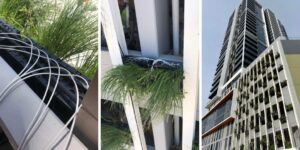Top tips for making your irrigation ‘smarter’
By Gabrielle Stannus –
Think your green wall’s irrigation is ‘smart’ because it is hooked into Wi-Fi? Nigel Thompson, Managing Director and Head Water Technician at Earth & Water, shares his top tips to help you make your irrigation system truly smart.
Nigel began his working life as a farmer from Kenya, using Israeli irrigation technology to water strawberries and other crops. After moving to Perth, Nigel now specialises in water treatment, irrigation services and green walls. His team has constructed indoor green walls at Western Power, Globe Hotel and the Reva Apartments. Nigel calls green walls the Ferraris or Maseratis of gardening. “If you just have a common garden and a bit of a lawn with a few sprinklers dotted about people do not care when things look a bit patchy,” says Nigel, “However, when your client spends $2,500 a square metre for a commercial green wall, then they do care.”

To ensure that green walls look their best, Nigel carefully plans their irrigation design, considering fertiliser needs, monitoring requirements and future maintenance. Nigel creates irrigation zones that operate independently within a wall to avoid what he calls the ‘dribble down effect’ whereby water and fertiliser leachate can accumulate at the bottom of the wall. “We only irrigate about four metres in total, top to bottom, within the same irrigation zone, with the same set of drippers all popping on and off as each irrigation system comes on for one minute. They all turn on for one minute and then they smack shut at the same time, so each cell gets the same amount of water.” Earth & Water use high-pressure compensated non-leakage (H-CNL drippers) in green walls given the height difference between the top and bottom of these walls.

“People need to consider the consequences of failure and how to address it. I normally go with small zones. I introduce the sub-main into the middle of the manifold, so that the travel distance from the distribution point to each final dripper is generally about the same and not more than about 25-30 seconds,” Nigel explains. From his smart phone or office, Nigel has access to real-time information from over 200 irrigation controllers that he can monitor and control remotely.
“Every single irrigation business now is putting its hand up to say its irrigation controllers are ‘smart’, e.g. Hunter, Rain Bird, Signal, Motorola, Netafim,” claims Nigel, “The cheapest start at around $300 to $500 for an irrigation controller that hooks up to Wi-Fi and that might interrogate the weather station and will send you an alert if there is a failure.” Whilst hyper-localised weather sensors measure for wind speed, rainfall and temperature, these parameters are not required indoors. What is practical indoors is a flow meter to monitor for leaks and blockages. “Whenever flow is 10% above or below normal, we program our smart irrigation systems to automatically turn off the affected zone,” says Nigel.
Can your technicians access and understand this data? Is the program compatible with your existing office and field devices, e.g. PC, Mac, iPhone, iPad and Android?

Nigel also recommends those irrigation systems that allow for a proportional fertiliser regime, or what he calls a ‘perfume’, over a dump fertigation program. “If you come every two or three months and put in five litres of Seasol, fish or kelp, then you are going to get a smelly result. If someone is sitting there at breakfast in the hotel at that time, they will not be happy. Their Google review will say ‘This hotel stinks’”, says Nigel. Injecting proportional amounts of fertiliser at 3-5 parts per million (PPM) into a green wall’s irrigation system means it is almost immeasurable and undetectable.
“Commercial settings include restaurants, cafes and shared communal spaces such as apartment gardens. In these interiors many people may have access to the smart irrigation system including employees, administration and property/facility managers. Our goal is to limit access to only a few end users and have a clear procedure on how to deal with issues as they arise. Spend time planning and setting up the alerts and programming at the start to reduce confusion later,” concludes Nigel.
Gabrielle Stannus
Inwardout Studio
M: 0400 431 277
E: gabrielle@inwardoutstudio.com
Board Member, Interior Plantscape Associationwww.interiorplantscape.asn.au

